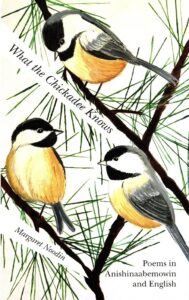Book review: What the Chickadee Knows: Poems in Anishinaabemowin and English
What the Chickadee Knows: Poems in Anishinaabemowin and English is Margaret Noodin’s second poetry collection in Anishinaabemowin and English that calls upon the reader to listen to the sounds, connected words, and visualizations. Noodin’s collection explores nature, tradition, and history through a variety of forms all centred within the Anishinaabeg worldview and emphasizing the myriad of relationships that define our worlds. With each poem written in Anishinaabemowin and then translated by Noodin into English, an immediate and intimate connection between two disparate languages emerges while maintaining a description of the world via an Anishinaabe paradigm. The poetry, in both languages, is meant to be read aloud to give the reader access to how “our world is shaped by the sounds around us and the filter we use to turn thoughts into words”(ix).
Noodin expects the reader to verbalize each poem, both in Anishinaabemowin and English to experience the sounds of the worlds around us. To this end, she provides a brief instruction on how to pronounce Anishinaabemowin. While non-speakers may stumble, the sounds spark and form a window into another way of seeing that is explained through the English translation. Additionally, the reader can begin a path of understanding by listening to the different sounds and lyrical formations in either language. This approach makes Noodin’s poetry collection unique and powerful.
The collection is divided into two sections. The first section, “E-Maaminonendamang / What We Notice”, seeks to “illustrate the way Anishinaabemowin blends philosophy, science, and psychology”(x). This is readily evidenced in “Agoozimakakiig Idiwag / What the Peepers Say” where Noodin speaks of the spring peepers that welcome the new season of rebirth through their calling (8-9).
The second section, “Gaa-Ezhiwebag / History”, explores commonly known histories as well as lesser known events (x). “Gaa-Ezhiwebag” is my favourite section of the collection. Its lyrical rhythms wondrously captures the back and forth of the past, its contentiousness, as well as the importance of knowing to allow for healing. For example, “A Sandy Healing Song” likens the disastrous 1850 Chippewa treaty payments at Sandy Lake to the disastrous events experienced by the Cheyenne in 1864 at Sand Creek (54-57). Both events are linked by American incompetence and duplicity, as well as the death of many Chippewa and Cheyenne. The poem evokes the events, confusion, and suffering as well as legacy through “a sneak-up dance of survival / … /a healing song /… /never forgetting”(57).
Overall, What the Chickadee Knows, is a wonderful read. It offers a view for all readers, Anishinaabeg or settler, an audible exploration of the depth of contemporary Anishinaabeg culture, understanding, and worldview as tied through the intimacy of myriad relationships. I believe that this little volume is readily readable by anyone who sees poetry as a way to access deeper aspects of cultural philosophies and individual expressions. It is also an important read for Anishinaabeg seeking to share and learn through a lyrical rhythmic world-making.
Margaret Noodin, What the Chickadee Knows: Poems in Anishinaabemowin and English. Detroit: Wayne State University Press, 2020.



